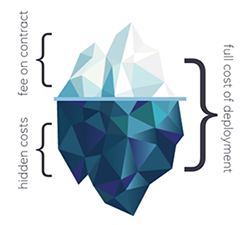Hidden Costs of Managing Multiple Vendors
To keep up with big technology, financial institutions are looking towards third-party vendors and fintech firms
- |
- Written by Kylee Wooten, Abrigo

To satisfy increasingly digital consumers and keep up with big technology players in the banking industry, financial institutions are looking towards third-party vendors and fintech firms to help digitize offerings, automate processes, and create efficiencies. These collaborations between fintech and financial institutions have helped institutions increase revenues, generate new offerings and new business, and enhance the borrower experience.
However, there is a seemingly endless number of technologies available today and it is becoming more common to manage multiple vendor relationships. Multi-vendor relationships can be beneficial for flexibility and price negotiation; however, they can also lead to increased complexity and hidden costs – both financially and in the form of time and resources.
While larger institutions may be able to afford dedicated staff for vendor management, smaller financial institutions will likely need employees to wear additional hats in order to manage these new relationships.
If your institution is considering leveraging a third-party for technology or service, it’s important to consider the big picture of your institution’s goals as well as the obvious or hidden costs of selecting a given technology or services provider. If your financial institution is seeking out a partnership to streamline processes or create scalable growth, consider these factors before you tap a new vendor versus adding functionality from an existing vendor partner.
-
 Hidden financial costs. When seeking out partnerships and third-party vendors, a big factor is often price, and although most buyers will price-compare different vendors, they may neglect to delve into and consider hidden financial costs. Ernest Hemingway used the Iceberg Theory in his writing to stay focused on the most important elements of his story (the portion of the iceberg that’s above the surface) without overwhelming the reader with details (what’s below the surface). If you apply this paradigm to technology purchases, however, the buyer wants to know the full cost of deployment – the whole iceberg - and not just the fee shown on a contract. The risk of hidden financial costs increases with multiple vendors, as does the risk of incompatibility between the technology. By leveraging a single vendor instead of multiple vendors, institutions can have confidence that the various products from the provider will “talk” and will be able to work together seamlessly. There will be less data entry, more cross-application features, and better overall reporting. Plus, by leveraging multiple products from the same vendor, rather than purchasing them ad-hoc from multiple vendors, there is a greater chance of price bundling to soften upfront costs.
Hidden financial costs. When seeking out partnerships and third-party vendors, a big factor is often price, and although most buyers will price-compare different vendors, they may neglect to delve into and consider hidden financial costs. Ernest Hemingway used the Iceberg Theory in his writing to stay focused on the most important elements of his story (the portion of the iceberg that’s above the surface) without overwhelming the reader with details (what’s below the surface). If you apply this paradigm to technology purchases, however, the buyer wants to know the full cost of deployment – the whole iceberg - and not just the fee shown on a contract. The risk of hidden financial costs increases with multiple vendors, as does the risk of incompatibility between the technology. By leveraging a single vendor instead of multiple vendors, institutions can have confidence that the various products from the provider will “talk” and will be able to work together seamlessly. There will be less data entry, more cross-application features, and better overall reporting. Plus, by leveraging multiple products from the same vendor, rather than purchasing them ad-hoc from multiple vendors, there is a greater chance of price bundling to soften upfront costs.
-
Time and resources. Additionally, consider the added time and resources needed to administer each relationship, including vetting potential vendors, completing due diligence reports, paying invoices, and managing support staff and implementation timelines. Each contract may have different start dates, renewals, and terms – and it requires someone to track each piece. Andy Snow, Vice President of Implementation at Abrigo, recommends that institutions name an executive sponsor to ensure staffing resources are committed to onboarding new technology and appropriately training staff. “The longer an implementation is deferred, the more risk threatens the project’s goals,” Snow said in a recent BAI article. “A fully engaged organization with executive support reduces those risks.”
While having an executive sponsor is important to a successful transition, keep in mind that this project is in addition to his or her day-to-day responsibilities, as well as the rest of the team’s day-to-day as they are trained on the new product. Consolidating vendors can alleviate the time and resources needed to properly implement and train staff members.
-
Training and support. You want to make sure your institution is getting a solid return on its investment, which starts with adequate training and support from the vendor. The implementation and integration process can be very time consuming and complex. Add multiple vendors and their respective implementation processes into the equation, and deployment can seem unending. With a single vendor, institutions can expect a more streamlined integration process since the software will have similar interfaces, features, and applications. As your institution looks to add new products into the mix, it will take staff significantly less time to get comfortable and up to speed with the features because of prior experience with the vendor’s products.
And if help is needed, it’s a lot easier to make the call to one vendor, rather than an entire roster of third-parties. Support with a single contact is just a phone number away. This support contact will be familiar with all of the products your institution uses and will be able to get a solution back to you more quickly.
-
Trusted advisors. With a single vendor, your institution will have a deeper relationship with one trusted advisor, which can greatly reduce integration and support pressures. When your institution is in frequent communication with a third-party, it becomes much easier to build a relationship and trust than it is in a multi-vendor environment where communication is less frequent. If you’re having an issue with your product, your institution simply needs to make one phone call, whereas multi-vendor relationship can send your institution on a wild goose chase tracking down one vendor after the next before your issue is resolved. Software from the same vendor also lends itself to greater accountability with less finger pointing.
There is no right or wrong approach when it comes to single- or multi-vendor relationships. However, it is important to weigh the pros and cons before investing in a third-party solution. The price tag you see isn’t always the price that you get. Be diligent in vetting out potential vendors and find simplicity in implementation when you can.
Ultimately, these relationships should offer your institution greater efficiency and scalability, so consider these points when determining whether or not a vendor is right for you.
Tagged under Technology, Tech Management, Outsourcing/Cloud, Feature3, Fintech, Feature, Management, Duties,













